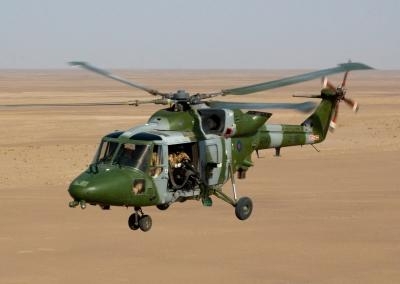Last Of 22 Aircraft Built Under An Urgent Operational
Requirement Contract
A ceremony was held Thursday at AgustaWestland’s Yeovil
facility to mark the completion of the Lynx Mk9A program and the
scheduled delivery of the 22nd and final Lynx AH Mk9A helicopter to
the British Army Air Corps in December 2011. The twenty-two
aircraft program was the result of Urgent Operational Requirement
contracts placed in November 2008 and March 2010 and will be
completed three months ahead of schedule. The ceremony was hosted
by Graham Cole, Chairman, AgustaWestland Ltd, with the guest of
honour being Brig James Illingworth, Deputy Commander of the Joint
Helicopter Command & Director of Army Aviation.

“The delivery to time and cost of this urgent operational
requirement to enhance the Lynx Mk9 fleet has given Theatre
Commanders a much more capable and versatile light helicopter,"
said Defence Equipment & Support’s Director, Helicopters,
Adrian Baguley. "This was a truly outstanding example of joint
working between the DE&S Lynx project team and
AgustaWestland.”
In December 2008 AgustaWestland was awarded an Urgent
Operational Requirement (UOR) contract to upgrade twelve Lynx AH
Mk.9 aircraft. The CTS800-4N engines, which transform the
performance of the Lynx AH Mk.9, were pulled forward from the AW159
Lynx Wildcat program along with other equipment. The new engines
produce 37% more power than the Gem engines fitted to the original
Lynx AH Mk.9 giving the Mk.9A a significant increase in power
allowing it to operate in extreme hot and high conditions at high
weights. The Lynx AH Mk.9A upgrade required modifications to be
carried out to the main gear box, top deck structure and rear
fuselage to accommodate the CTS800-4N engines. Additionally changes
were carried out in the cockpit for the new engine controls and
digital displays.
Under this Urgent Operational Requirement (UOR) contract,
AgustaWestland commenced work even before contract award to ensure
the program could be completed as rapidly as possible. A
written-off airframe supplied by the Ministry of Defence was used
to trial the installation and changes required to the top deck
structure of the aircraft, as a risk reduction exercise. Similarly
AgustaWestland’s Super Lynx 300 demonstrator aircraft has
been used to perform a range of trials in support of the program to
speed up the qualification process prior to entry into service.
The first flight of the Lynx AH Mk.9A took place just 10 months
after contract award on 16th September 2009 at
AgustaWestland’s Yeovil facility. Other activity in late 2009
included the provision of a comprehensive support package including
an initial spares package, integrated electronic technical
publications and training. The training package included training
for aircraft and avionic technicians as well as aircrew and was
completed by the end of November 2009.

In December 2010, just 12 months after contract award
AgustaWestland delivered the first four upgraded Lynx AH Mk.9A
helicopters to the British Army. Three of these four aircraft
were used by the Army Air Corps for conversion to type and
conversion to role training at its Dishforth base in Yorkshire and
in early-2011 for pre-deployment training in Kenya.
In March 2010 AgustaWestland was awarded a contract extension by
the UK Ministry of Defence for the upgrade of 10 more British Army
Lynx Mk.9 helicopters. This contract meant all of the British
Army’s 22 Lynx Mk.9 helicopters were to be upgraded to Mk.9A
standard in a seamless conversion program.
Following the completion of pre-deployment training the first
batch of Lynx AH Mk.9As were deployed to Afghanistan in April 2010
where they immediately went to work. The ability to operate all
year round at high altitude with greatly enhanced payload made the
“nine alpha” an extremely valuable asset in theatre for
British and coalition forces. (Photos provided by
AgustaWestland)
 Airborne 04.16.24: RV Update, Affordable Flying Expo, Diamond Lil
Airborne 04.16.24: RV Update, Affordable Flying Expo, Diamond Lil ANN's Daily Aero-Term (04.20.24): Light Gun
ANN's Daily Aero-Term (04.20.24): Light Gun Aero-News: Quote of the Day (04.20.24)
Aero-News: Quote of the Day (04.20.24) Aero-News: Quote of the Day (04.21.24)
Aero-News: Quote of the Day (04.21.24) ANN's Daily Aero-Term (04.21.24): Aircraft Conflict
ANN's Daily Aero-Term (04.21.24): Aircraft Conflict




